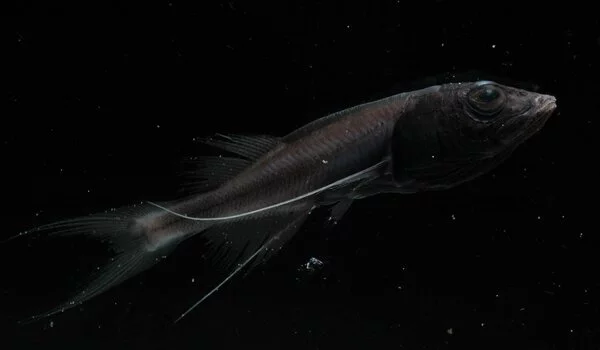The deep sea contains more than 90% of the water in our oceans, but only about one-third of all fish species. Scientists have long thought the explanation was obvious: shallow ocean waters are warm and rich in resources, making them an ideal environment for new species to evolve and thrive. However, according to a new University of Washington study led by Elizabeth Miller, there were several periods in Earth’s ancient history when many fish actually preferred the cold, dark, barren waters of the deep sea.
“It’s easy to look at shallow habitats like coral reefs, which are very diverse and exciting, and assume that they’ve always been that way,” said Miller, who completed the study as a postdoctoral researcher at the University of Washington and is now a postdoctoral fellow at the University of Oklahoma. “These findings challenge that assumption and help us understand how fish species have adapted to major climate changes.”
The deep sea is typically defined as anything below 650 feet, the depth at which there is no longer enough sunlight to support photosynthesis. As a result, there is significantly less food and warmth than in the shallows, making it a difficult place to live. Miller discovered a surprising evolutionary pattern by analyzing fish relationships using genetic records dating back 200 million years: speciation rates, or how quickly new species evolved, flipped over time. There were tens of millions of years when new species evolved faster in the deep sea than in shallower areas.
It’s easy to look at shallow habitats like coral reefs, which are very diverse and exciting, and assume that they’ve always been that way. These findings challenge that assumption and help us understand how fish species have adapted to major climate changes.
Elizabeth Miller
In some ways, this discovery raised more questions than it answered. What was causing fish to prefer one habitat over another? What made some fish able to move into the deep sea more easily than others? And how did these ancient shifts help create the diversity of species we have today?
When Miller mapped these flip-flopping speciation rates onto a timeline of Earth’s history, she was able to identify three major events that likely played a role.
“The first was the breakup of Pangea, which occurred between 200 and 150 million years ago,” said Miller. “That created new coastlines and new oceans, which meant there were more opportunities for fishes to move from shallow to deep water. There were suddenly a lot more access points.”
Next was the Cretaceous Hot Greenhouse period, which occurred approximately 100 million years ago and marked one of the warmest eras in Earth’s history. During this time, many continents were flooded due to sea-level rise, creating a large number of new, shallow areas across the earth.
“It was around this period that we really see shallow-water fishes take off and diversify,” said Miller. “We can trace a lot of the species diversity we see in the shallows today to this time.”

The third event was another major climatic change about 15 million years ago, known as the middle Miocene climatic transition. This was caused by further continent shifting, which caused major changes in ocean circulation and cooled the planet all the way down to the deep sea.
“Around this time, we see deep-sea speciation rates really accelerate,” Miller said. “Cold-water fishes were particularly responsible for this. Many of the species found today off the coasts of Washington and Alaska evolved during this time.”
However, climate change alone cannot explain how fish came to colonize the deep sea in the first place. Not every species has the right combination of traits to survive in deeper water and make use of the relatively limited resources beyond the reach of sunlight.
“To evolve into a new species in the deep sea, first you have to get there,” said Miller. “What we found was that not only were the speciation rates flip-flopping through time, but what the deep-sea fishes looked like was as well.”
The first fish to be able to transition into the deep sea had large jaws. These most likely increased their chances of catching food, which can be scarce at depth. The researchers discovered that fish with longer, tapered tails were more successful at making the transition to deep water much later in history. They were able to save energy by scooting along the seafloor rather than swimming in the water column.
“If you look at who lives in the deep sea today, you’ll notice that some species have tapered bodies and others have big, scary, toothy jaws,” Miller explained. “Those two body plans are the descendants of ancestors who colonized the deep sea millions of years apart.”
While these events may appear to be from the distant past, they may be able to teach us about how today’s changing climate will impact life in our oceans. Miller hopes that future research will build on these findings to investigate how modern deep-sea fish will respond to climate change and, as a result, help inform conservation efforts.
“What we learned from this study is that deep-sea fishes do better when the oceans are colder, but with climate change, the oceans are warming,” she explained. “We can expect this to have a significant impact on deep-sea fish in the coming years.”
















